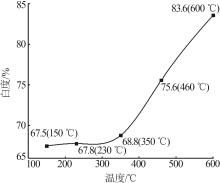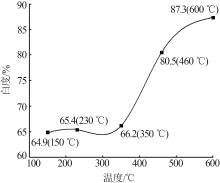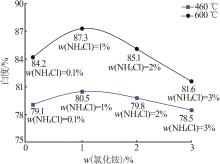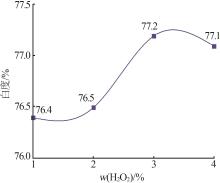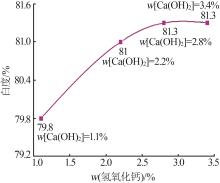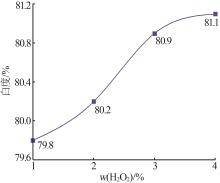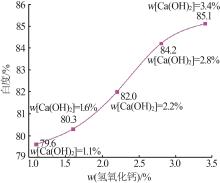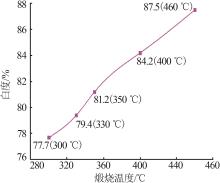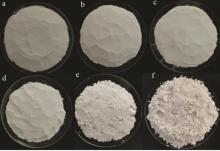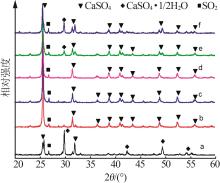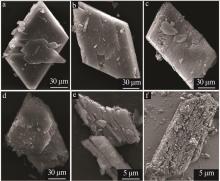| [1] |
LENG Manxi, ZHU Yu, YAN Jikang, XIE Ke, ZOU Yongjie.
Study on crystallization characteristics and mineral flotation performance of industrial waste phosphogypsum
[J]. Inorganic Chemicals Industry, 2025, 57(3): 108-115.
|
| [2] |
TAN Shanyi, WEN Huizi, HE Shuyu, ZHANG Liwen, CHEN Shaohua, XI Benjun.
Study on leaching behavior and kinetics of phosphorus from phosphogypsum
[J]. Inorganic Chemicals Industry, 2025, 57(2): 105-112.
|
| [3] |
SONG Jiaxi, JI Renfei, CHEN Jun, LIN Sen, YU Jianguo.
Research on characteristics analysis and pretreatment on deeply deactivated power battery ternary cathode materials
[J]. Inorganic Chemicals Industry, 2025, 57(2): 44-49.
|
| [4] |
TANG Kaijing, LIU Chuanbei, LI Yingding, JIANG Yong, WU Junnan, ZHANG Tao.
Research on preparation and mechanism of superhydrophobic phosphogypsum products
[J]. Inorganic Chemicals Industry, 2025, 57(1): 97-102.
|
| [5] |
TANG Dongwu, YE Changwen, DENG Jie, AO Fang.
Study on leaching rate of calcium and magnesium from phosphorus tailings based on thermodynamic analysis and response surface method
[J]. Inorganic Chemicals Industry, 2024, 56(9): 98-106.
|
| [6] |
SUN Lan, CHEN Shiying, YANG Liuxu, NIU Yiming, ZHAO Aonan.
Basic study on fixing soluble phosphorus in phosphogypsum with magnesium slag
[J]. Inorganic Chemicals Industry, 2024, 56(8): 92-98.
|
| [7] |
HU Cheng, LIU Meng, XIANG Weiheng, CHEN Ping, WANG Neng, LU Guanju, ZHOU Jinlan.
Preparation of α-hemihydrous gypsum from CaCl2 and MgCl2 and their composite solution
[J]. Inorganic Chemicals Industry, 2024, 56(7): 112-117.
|
| [8] |
HU Dian, GUO Ze, ZHANG Hanquan, LU Manman.
Research on effects of roasting process and typical impurities on reduction and decomposition process of phosphogypsum
[J]. Inorganic Chemicals Industry, 2024, 56(7): 88-95.
|
| [9] |
LIU Hui, WANG Hongliang, YU Kun, GAO Shengnan.
Effect of calcination on porous structure and electrochemical properties of air electrode
[J]. Inorganic Chemicals Industry, 2024, 56(6): 80-86.
|
| [10] |
HU Cheng, LIU Meng, XIANG Weiheng, DUAN Pengxuan, LI Shunkai, MING Yang, WANG Neng, LU Guanju.
Effect of NaCl solution concentration on transcrystallization behavior of α-hemihydrate gypsum from phosphogypsum
[J]. Inorganic Chemicals Industry, 2024, 56(6): 87-93.
|
| [11] |
TU Yanping, BAI Dengxian, CHENG Shukai, XIE Junjie, HUANG Zhiliang, CHEN Guofu.
Effect of high temperature modification of mineral powder and quicklime on properties of phosphogypsum cement based materials
[J]. Inorganic Chemicals Industry, 2024, 56(6): 94-101.
|
| [12] |
WANG Mingshun, AO Xianquan, YUAN Xing, DONG Wenyan, CHEN Qianlin.
Study on effect of crystallizer on preparation of anhydrous calcium sulfate from phosphogypsum
[J]. Inorganic Chemicals Industry, 2024, 56(5): 101-107.
|
| [13] |
DENG Fuli, XIA Zhixiang, LONG Bingwen, ZHANG Yi, DAI Yafen, WANG Bin, DING Yigang.
Study on purification process of phosphogypsum by reverse flotation
[J]. Inorganic Chemicals Industry, 2024, 56(5): 115-120.
|
| [14] |
FANG Xiaoning, KUANG Fei, LIU Chenglin.
Study on extraction of potassium from K-feldspar by roasting-leaching of mixed salts
[J]. Inorganic Chemicals Industry, 2024, 56(5): 53-57.
|
| [15] |
WANG Shengchang, HAO Jianying, CHEN Jianing, TIAN Bo.
Effect of calcination on properties of calcined gypsum prepared from desulphurization gypsum with potassium aluminum sulfate
[J]. Inorganic Chemicals Industry, 2024, 56(4): 105-111.
|
 ), WANG Meibo, XU Li, ZHANG Xujie, TAI Shijun, YI Xianmei, LIU Hongjuan, PAN Linyi
), WANG Meibo, XU Li, ZHANG Xujie, TAI Shijun, YI Xianmei, LIU Hongjuan, PAN Linyi
